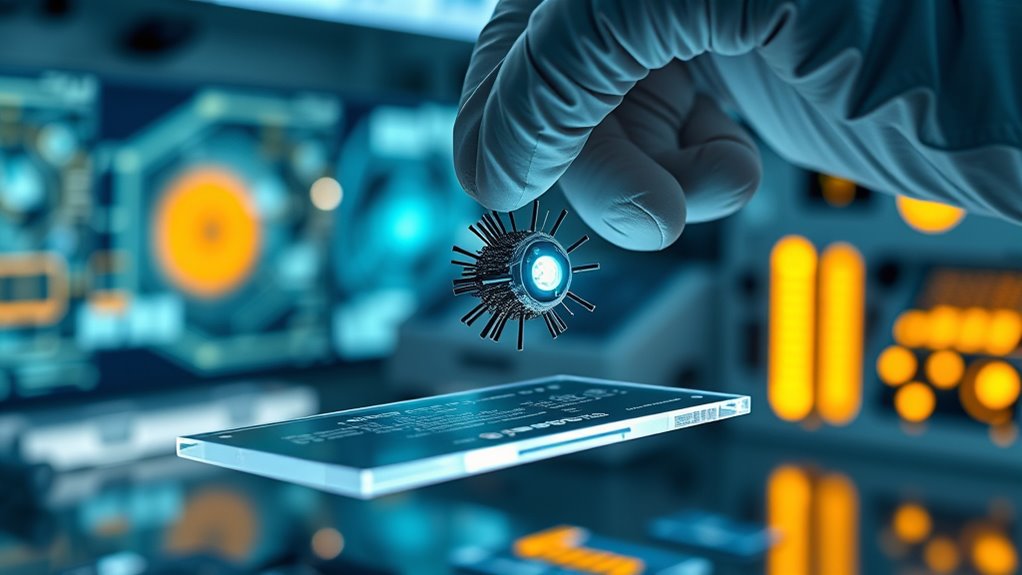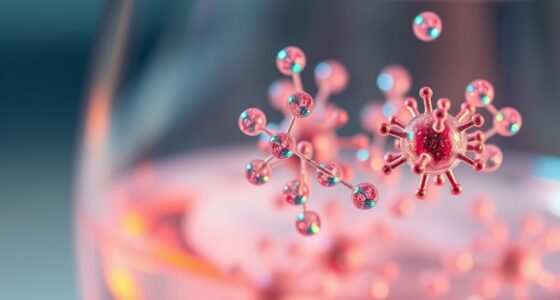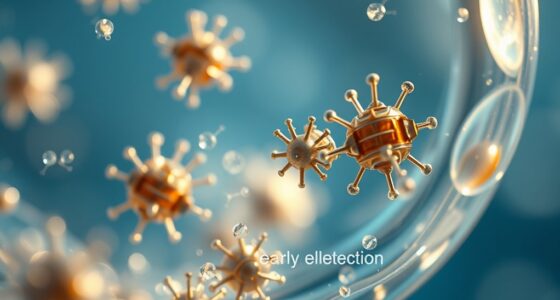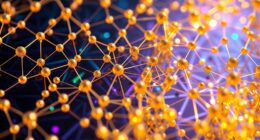Nanotech-enhanced diagnostics use tiny materials like quantum dots and nanoparticles to improve medical testing. These advancements make it possible for you to get faster, more sensitive, and accurate results, often with portable devices. They enable early detection of diseases and allow multiple tests at once, saving time and money. If you want to discover how these innovations are transforming healthcare and what they mean for you, keep exploring what’s next.
Key Takeaways
- Nanomaterials like quantum dots improve biosensor sensitivity for detecting low-abundance biological targets.
- Signal amplification techniques enable rapid, real-time diagnostics with high precision.
- Portable nanotech-based devices provide quick, on-site testing for remote or underserved areas.
- Multiplexed biosensors allow simultaneous detection of multiple disease markers from a single sample.
- Ongoing nanotech advancements promise faster, more accurate, and personalized diagnostic solutions.

Biosensor advancements powered by nanotechnology are transforming diagnostic tools into highly sophisticated devices. These biosensors leverage the unique properties of nanomaterials, like quantum dots, to detect minute quantities of biological molecules. When a target molecule binds to the biosensor, it triggers a measurable signal, often a change in fluorescence or electrical activity. The incorporation of quantum dots amplifies this signal, making it easier to identify low concentrations of pathogens or disease markers. As a result, healthcare providers can diagnose infections, cancer, and other conditions faster and more accurately than ever before. These innovations also enable real-time monitoring, which is essential for managing chronic illnesses or tracking treatment responses. Decoding slang and informal language have become increasingly important in understanding how people communicate in casual settings.
Moreover, the compact size of nanomaterials allows for the development of portable diagnostic devices. Imagine handheld tools that can analyze blood, saliva, or urine within minutes, providing immediate results. This is especially transformative in remote or underserved areas where access to laboratory testing is limited. The integration of quantum dots in biosensors also opens doors for multiplexed detection, meaning multiple diseases or markers can be identified simultaneously from a single sample. This not only saves time but reduces the need for multiple tests, cutting costs and complexity in medical workflows.
As research progresses, the potential of quantum dots and other nanomaterials in biosensor technology continues to grow. They promise a future where diagnostics are faster, more accurate, and accessible to everyone. By harnessing the power of nanotech, you’re looking at a new era of personalized medicine—one where early detection can save lives, and treatments can be tailored to individual needs. The tiny particles that once seemed insignificant are now at the forefront of a medical revolution that could redefine how we diagnose and treat disease.
Frequently Asked Questions
What Are the Potential Risks of Nanotech in Medical Diagnostics?
You should consider that nanotech in medical diagnostics poses risks like ethical concerns around privacy and consent, as well as environmental impact from nanoparticle disposal. These tiny materials might unintentionally harm ecosystems or human health if they accumulate or escape into the environment. Additionally, you might face challenges ensuring proper regulation and safety standards, making it vital to carefully evaluate long-term effects before widespread adoption.
How Cost-Effective Are Nanotech-Based Diagnostic Tools?
Think of nanotech-based diagnostic tools as tiny but mighty detectives. Their manufacturing costs are currently high, making them a bit like rare gems. However, as technology advances and production scales up, market affordability improves, turning these tools into accessible assets for healthcare. Over time, their cost-effectiveness will likely grow, helping you get quicker, more precise diagnoses without breaking the bank.
What Regulatory Challenges Exist for Nanotech Diagnostics Approval?
You face significant regulatory hurdles when seeking approval for nanotech diagnostics. The approval processes are complex due to concerns over safety, environmental impact, and standardization. You must demonstrate thorough testing, address potential toxicity, and guarantee consistent manufacturing practices. Managing these challenges requires careful documentation and compliance with evolving guidelines, which can delay market entry. Staying informed about regulatory updates and engaging with authorities early can help you overcome these approval process hurdles efficiently.
How Do Nanomaterials Improve Diagnostic Sensitivity and Accuracy?
Did you know nanomaterials can boost diagnostic sensitivity by up to 1000 times? You see, quantum dots are tiny, highly stable nanomaterials that emit bright, specific signals. Surface functionalization allows you to attach target molecules, increasing selectivity. This combination enables you to detect diseases earlier and more accurately, transforming diagnostics. By leveraging quantum dots and surface functionalization, you improve both sensitivity and precision, making your diagnostics markedly more reliable.
What Future Innovations Are Expected in Nanotech-Enhanced Diagnostics?
Future innovations in nanotech-enhanced diagnostics include smart wearables that continuously monitor health markers with high precision. You can expect personalized medicine to become more tailored, as nanomaterials enable early detection of diseases at a molecular level. These advances will make diagnostics faster, more accurate, and accessible, empowering you to take proactive control of your health and enabling clinicians to develop targeted treatments with unprecedented precision.
Conclusion
You can see how nanotech-enhanced diagnostics are revolutionizing healthcare, offering faster and more precise results. Like a finely tuned microscope revealing hidden details, these innovations let you detect diseases earlier and more accurately. As technology continues to evolve, you’ll find yourself at the forefront of a medical breakthrough, where tiny nanodevices hold the power to transform lives. Embrace this future, knowing that nanotech is opening doors like a key unfastening endless possibilities.









